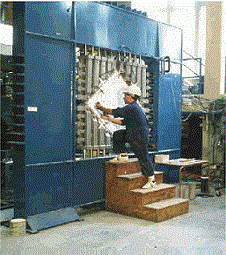Research Background
The Modified Compression Field Theory (MCFT) was developed over 35 years ago as a rational model for describing the behaviour of reinforced concrete. Cracked reinforced concrete was modelled as a composite continuum material using a smeared, rotating crack approach. Conditions of compatibility and equilibrium were formulated in terms of average stresses and average strains, but consideration was also given to local conditions at crack locations. Mechanisms such as compression softening due to transverse cracking, and post-cracking tensile stresses due to tension stiffening, were identified as significant influencing factors. These were embodied in new constitutive relations based on data derived from the testing of panels under general in-plane stress conditions; the first time such tests had been successfully completed. Since then, testing has included over 150 specimens on the 'Panel Element Tester' and 100 specimens on the 'Shell Element Tester' (see right), reaffirming the relationships derived. Various refinements to the analytical model followed; most notably, the Disturbed Stress Field Model (DSFM) which allowed for divergence of principal stress and strain directions and better modelled shear slip along crack surfaces.
Concurrent with the experimental and theoretical research, work was directed towards implementing the MCFT models and constitutive relations into advanced nonlinear analytical procedures. The programs developed include: VecTor1, for the analysis of beam sections subjected to combined shear, moment and axial load; VecTor2, for nonlinear finite element analysis (NLFEA) of 2-D membrane structures; VecTor3, for NLFEA of 3-D solid structures; VecTor4, for NLFEA of plates and shells; VecTor5, for plane frames subjected to thermal and mechanical loads; and VecTor6 for NLFEA of solids of revolution. Generally, the algorithms have employed a full-load, secant-stiffness formulation that has proven to be particularly stable and robust at all stages of response.
An integral part of the methodology has been to employ tests of complex large-scale structures as a means of corroborating the theoretical models and analytical procedures. Various test programs have involved two-storey frames, strip-slab-and-column subassemblies, flat slabs subjected to thermal loads, cylindrical shells subjected to hydrostatic loads, and 3-D shear walls subjected to reversed cyclic loads, to name a few. Comparisons of observed to predicted behaviour show the MCFT to provide accurate simulations of response over a wide range of structural types and loading conditions.
Also essential to the research has been the opportunity to apply the analytical procedures to practical problems, thereby exposing needs and shortcomings in the formulations if they exist. The analysis programs have been used in numerous consulting assignments involving offshore platforms, nuclear containment structures, bridges, silos, shear walls, and slab and frame structures. In such cases, the analyses provided a means of accurately investigating complex nonlinear behaviour to a degree that was difficult or impossible by other means. For example, analyses were made of the Sleipner A platform whose collapse was attributed to a local shear failure in one of the buoyancy cells of the base structure. A VecTor3 analysis indicated that the single T-headed reinforcing bar provided in the tricell region was too short to maintain structural integrity.

Panel Tester

Shell Tester